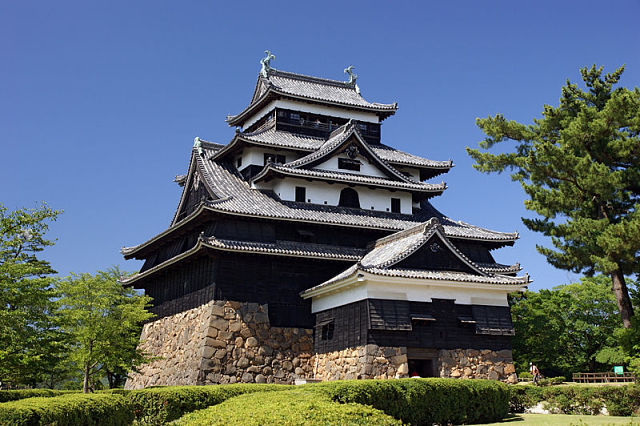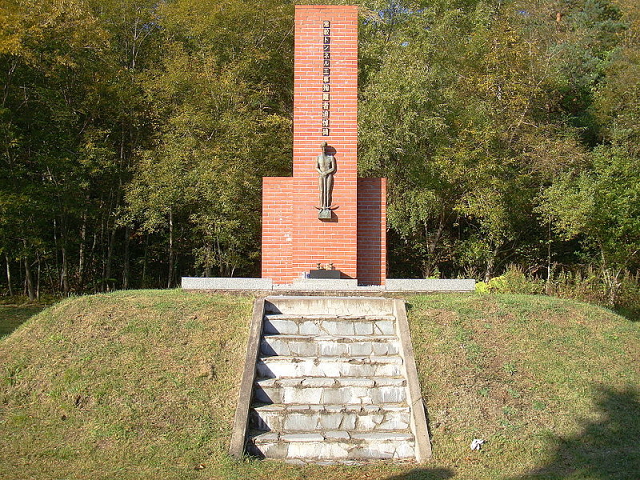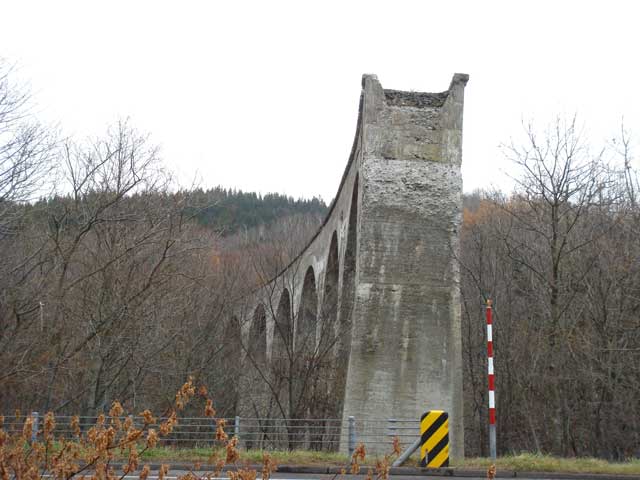Tales of "human pillars" (hitobashira) -- people who were deliberately buried alive inside large-scale construction projects -- have circulated in Japan since ancient times. Most often associated with castles, levees and bridges, these old legends are based on ancient beliefs that a more stable and durable structure could be achieved by sealing people inside the walls or foundation as an offering to the gods.

Was a young woman buried alive inside the wall of Matsue castle long ago?
One of the most famous tales of construction-related human sacrifice is associated with Matsue castle (Shimane prefecture), which was originally built in the 17th century. According to local legend, the stone wall of the central tower collapsed on multiple occasions during construction. Convinced that a human pillar would stabilize the structure, the builders decided to look for a suitable person at the local Bon festival. From the crowd, they selected a beautiful young maiden who demonstrated superb Bon dancing skills. After whisking her away from the festival and sealing her in the wall, the builders were able to complete the castle without incident.
However, the maiden's restless spirit came to haunt the castle after it was completed. According to folklorist Lafcadio Hearn, who described the castle's curse in his 1894 work "Glimpses of Unfamiliar Japan," the entire structure would shake anytime a girl danced in the streets of Matsue, so a law had to be passed to prohibit public dancing.
Although there is no conclusive evidence indicating that construction-related human sacrifice was actually practiced in Japan, it has been suggested that some laborers may, on occasion, have been terminated as a security measure after working on castles. Doing so would have prevented knowledge of a castle's secrets and weaknesses from falling into enemy hands.
Other notable structures rumored to make use of human pillars include:
- Gujo-Hachiman castle (Gifu prefecture)
- Nagahama castle (Shiga prefecture)
- Maruoka castle (Fukui prefecture)
- Ozu castle (Ehime prefecture)
- Komine castle (Fukushima prefecture)
- Itsukushima shrine (Hiroshima prefecture)
- Fukushima bridge (Tokushima prefecture)
- Kintaikyou bridge (Yamaguchi prefecture)
- Hattori-Oike reservoir (Hiroshima prefecture)
- Imogawa irrigation channel (Nagano prefecture)
- Karigane embankment (Shizuoka prefecture)
- Manda levee (Osaka prefecture)
Modern-day versions of these old legends can also be found on Japan's northern island of Hokkaido. Human bones have been found around several bridges and tunnels, lending an air of credibility to rumors that workers were sacrificed during construction.

Monument erected after skeletons were found sealed in the walls of Jomon tunnel
Jomon tunnel, constructed on the Sekihoku Main Line (JR Hokkaido) in 1914, is notorious for rumors of human sacrifice. In 1968, the tunnel underwent repairs after a major earthquake damaged part of the wall inside. While doing the renovations, workers found a number of human skeletons, standing upright, sealed inside the walls. A large quantity of human bones were also unearthed near the tunnel. The discovery fueled beliefs that the tunnel was constructed with human pillars, and many people -- including train conductors -- came to fear that the tunnel was haunted by the ghosts of the victims.
Some theories suggest that brutal working conditions and poor nutrition led many workers -- mainly criminals and debtors working against their will -- to contract beri beri, a deadly nervous system ailment. With no access to medicine, these victims are believed to have been buried alive near the construction site. A monument honoring the fallen workers was erected in 1980.

Were people sealed inside the concrete supports of Koshikawa bridge?
People are also rumored to have been sealed inside the concrete supports of Koshikawa bridge, on the now-defunct Konboku line (also in Hokkaido). While no actual human skeletons have been found, recent surveys have revealed the possible existence of hollow spaces in the structure that may contain human remains. Records indicate that at least 11 indentured workers may have died building the bridge, which was completed in 1939.
[Note: This is the latest in a series of weekly posts on Japanese urban legends.]

Vogelbeere
There is a similar legend in Britain, that the wizard Merlin was going to be made a foundation sacrifice, until he pointed out that the instability of the castle that King Vortigern was building was caused by two dragons fighting in a lake beneath the hill.
[]http://www.btinternet.com/~martin.edwardes/anthrop_vortigerns_castle.htm
Antonio Fidalgo
Your blog is very interesting. In fact is one of the most interesting Japan related blogs that I know.
[]I am following its posts some time ago, maybe already 2 years.
Undoubtedly there were people buried in constructions all over the world. The reasons could be diverse as you stated. I remind a story I read last year about a house, actually it was built to serve as photographic studio, in which the owner buried a man he killed or ordered to kill because he is disgracing his daughter. The young girl was completed in love with this man and after his disappearance she went crazy, ran away from home and spent years at capital's theaters doors in hope to locate his beloved. Some photos of Carlos Relvas' House-Studio can be seen here:
http://www.casarelvas.com/site/uk/php/casa_estudio.php
J. J. Markin
And there's a similar tradition in Romania. At least one 19th century travel book alludes to it.
[]Paul
May I just say that I always read your blog and I absolutely love it. I check it every weekday and learn a lot from it. The quality of the presentation of each post is superb. Congratulations and please keep it up.
[]Matthew Meyer
Amazing! I live 10 minutes from Maruoka castle, I should go check it out...
[]Rachel
could you write more on actual Japanese urban legends? I'm writing a research paper on them
[]Ren Villanueva
I heard similar stories from my Grandfather who worked as a civil engineer here in the Philippines. He said a goat would be sacrificed each time a bridge would be built across a creek or a river. For major bridges like San Juanico, they had to use children. I'm not so sure if he just told me those stories to scare me though.
[]ted
I lived for many years near Matsue, and while I never heard about a hitobashira (or ningenbashira, as I learned it)under the castle, there is supposed to be one beneath the middle support of a bridge nearby, on Lake Shinjiko.
[]HP
Some years ago, I watched a movie, made sometime in the last 10-15 years or so, about a convenience store in suburban Tokyo built on the site of an old daimyo built on human pillars. Needless to say, the ghosts are restless, and your Pocky purchase is fraught with peril. Can't remember the name of the move to save my life. I can't figure out how to search for it; does anyone remember the movie I'm talking about? Nice mix of graphic exploitation, universal bourgeois concerns, and Japanese culture.
[]matthew
I appreciate this timely post. I have to give a lecture in about two weeks about Japanese folk legends in light of Rene Girard's mimetic theory. For background material, I have ordered out of print books by Richard Dorson and Kunio Yanagita (translated) but they are probably not going to arrive in time. Therefore, I went to the net, but there is surprisingly little material online. Your thorough and comprehensive post is going to help me a lot!
Are you familiar with Rene Girard's work on sacred violence?
Thanks again! Excellent site!
[]michael
I've just come from a cherry blossom picnic today at the Hattori-Reservoir park near Fukuyama, Hiroshima. There is indeed a memorial statue dedicated to the alleged girl in the levee, O Ito san, as she is called. The statue is named "Human Pillar Ito's Statue" -人柱ãŠç³¸ä¹‹åƒ- Hito Bashira O Ito No Zou. The several meters tall statue stands on top of the levee and right beside an even larger monument dedicated to soldiers of WWII. Ito san is standing holding a large construction post in her right hand and an unknown something in the left. The heads of 2 dragons (Water Gods) are on each side of her. Above and behind her float 3 angels (?). One is blowing a horn, perhaps announcing her arrival in heaven (?). The middle angel appears to be removing Ito san's burial shroud and the other is holding a branch of cherry blossoms. The sign below the statue says that she was buried there about 300 years before. It's a fairly new statue, no more that 30 years old I'd guess.
Sorry if my guesses on the statue are way off. They were just my unqualified impressions. Curious about hito bashira (human pillars), I did a quick search and found this site. I'd love it if anyone could explain the meaning of statue.
[]Ru
Hi!! I'm interested in the site you were talking about!! In fact, I'm writing a research paper and any help is useful!!
[]Michael
Sorry, didn't see your message for a while. Email me any question you have. I don't know much but have some pictures.
I was there today for ohanami.
m
[]Os
I loved the post. I've heard about human sacrifices in buildings all over the world. Here in Bolivia up to some time ago it was know that when laying the foundation on a tall building a young male would be inebriated and thrown in the hole.
[]Hobittual
"London bridge is falling down" a nursery rhyme, alludes to the practice of burying children in the foundations of the bridge.
[]paul
while working in oita i heard from a student that women had been sacrificed until quite recently in cases such as drought. I am not quite sure as to what recent actually means but it seemes to mean until the edo period. does anyone know of any such cases?
[]